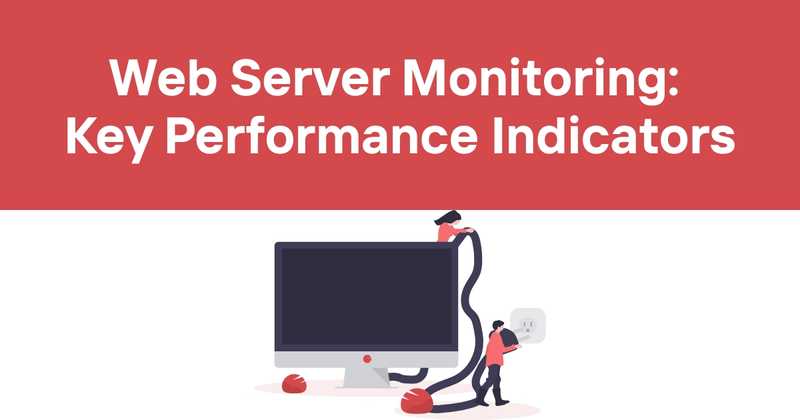Web Server Monitoring: Key Performance Indicators
Web servers are the backbone of the internet, powering countless websites and applications that we rely on daily. As a software developer, understanding how to effectively monitor these crucial components is key to maintaining a robust and reliable web presence. In this article, we'll dive into the world of web server monitoring, exploring the essential metrics you should track and best practices to keep your servers running smoothly.
Table of Contents
- Introduction to Web Server Monitoring
- Key Metrics for Web Server Monitoring
- Tools and Techniques for Effective Monitoring
- Best Practices for Web Server Monitoring
- Common Challenges and How to Overcome Them
- The Role of Alerts and Notifications
- Analyzing and Acting on Monitoring Data
- Scaling Your Monitoring Strategy
- Security Considerations in Web Server Monitoring
- Future Trends in Web Server Monitoring
- Conclusion
Introduction to Web Server Monitoring
I've been in the trenches of web development for years, and let me tell you, web server monitoring is not just a nice-to-have – it's absolutely critical. Think of it as the health checkup for your digital infrastructure. Without it, you're flying blind, hoping everything's okay until suddenly, it's not.
Web server monitoring involves keeping a watchful eye on various aspects of your server's performance, availability, and security. It's about catching issues before they become full-blown problems and ensuring that your web applications are running as smoothly as a well-oiled machine.
Key Metrics for Web Server Monitoring
Now, let's talk about the metrics that matter. These are the vital signs of your web server, and ignoring them is like ignoring chest pain – you're asking for trouble.
-
CPU Usage: This is the bread and butter of server monitoring. High CPU usage can indicate that your server is struggling to keep up with demand.
-
Memory Utilization: RAM is precious. If your server is running low on memory, it's going to start swapping to disk, and that's when things get sluggish.
-
Disk I/O: Slow disk operations can bottleneck your entire system. Keep an eye on read/write speeds and queue lengths.
-
Network Traffic: Bandwidth usage and network errors can tell you a lot about your server's health and potential security issues.
-
Request Rate: How many requests is your server handling per second? This metric can help you plan for traffic spikes.
-
Response Time: Nobody likes a slow website. Monitor how long it takes your server to respond to requests.
-
Error Rates: A sudden spike in 404s or 500s? That's a red flag you can't ignore.
-
SSL Certificate Status: An expired SSL cert can take down your entire site. Don't let it catch you off guard.
Here's a quick reference table for these key metrics:
| Metric | What It Measures | Why It's Important |
|---|---|---|
| CPU Usage | Processing power utilization | Indicates server load and capacity |
| Memory Utilization | RAM usage | Affects application performance |
| Disk I/O | Read/write operations | Can identify bottlenecks |
| Network Traffic | Bandwidth usage and errors | Shows server activity and potential issues |
| Request Rate | Requests per second | Helps in capacity planning |
| Response Time | Time to serve requests | Directly impacts user experience |
| Error Rates | Frequency of HTTP errors | Indicates application or server problems |
| SSL Certificate Status | Validity of SSL certificates | Crucial for security and site accessibility |
Tools and Techniques for Effective Monitoring
I've tried more monitoring tools than I care to admit, but here's the thing: the best tool is the one you'll actually use consistently. That said, some popular options include:
- Nagios: An oldie but a goodie. It's highly customizable but can be complex to set up.
- Zabbix: Open-source and feature-rich. Great for larger infrastructures.
- Prometheus: If you're into cloud-native setups, this one's for you.
- Datadog: A cloud-based solution that's easy to get started with.
But tools are just part of the equation. Effective monitoring also involves:
- Setting up proper logging: Detailed logs can be a lifesaver when troubleshooting.
- Implementing health checks: Regular checks can catch issues early.
- Using synthetic monitoring: Simulate user interactions to catch performance issues from the user's perspective.
Best Practices for Web Server Monitoring
Alright, time for some hard-earned wisdom. Here are some best practices I swear by:
-
Monitor from multiple locations: Your server might be up from your office, but what about for users in Asia or Europe?
-
Set realistic thresholds: Don't cry wolf with overly sensitive alerts. You'll just end up ignoring them.
-
Correlate metrics: One metric in isolation doesn't tell the whole story. Look for patterns across different metrics.
-
Keep historical data: Trends over time can reveal slow-developing issues before they become critical.
-
Monitor your monitoring: Yes, you read that right. Your monitoring system needs monitoring too. Who watches the watchmen? You do.
-
Automate where possible: Manual checks are error-prone and time-consuming. Automate routine monitoring tasks.
-
Document your monitoring setup: Trust me, you'll thank yourself later when trying to onboard new team members or troubleshoot at 3 AM.
Common Challenges and How to Overcome Them
Let's be real – monitoring isn't always smooth sailing. Here are some common roadblocks and how to get past them:
-
Information overload: Start with the essentials and gradually add more metrics as needed. Don't try to monitor everything at once.
-
False positives: Refine your alert thresholds and use correlation rules to reduce noise.
-
Lack of context: Integrate your monitoring with your deployment and change management systems. That weird spike might be due to a recent code push.
-
Resource overhead: Be mindful of the impact your monitoring tools have on server performance. Lightweight agents and sampling can help.
-
Scaling issues: As your infrastructure grows, your monitoring needs to keep up. Look for solutions that can scale horizontally.
The Role of Alerts and Notifications
Alerts are the nervous system of your monitoring setup. They tell you when something needs your attention. But here's the catch – bad alerting is worse than no alerting at all. Why? Because alert fatigue is real, and it's dangerous.
Here's how to set up effective alerts:
-
Prioritize: Not all alerts are created equal. Use different channels or urgency levels for different types of issues.
-
Use escalation: Start with a low-priority notification, then escalate if the issue isn't resolved within a set time frame.
-
Provide context: An alert should tell you what's wrong, where, and ideally, give you a starting point for investigation.
-
Allow for easy acknowledgment: Make it simple for on-call staff to acknowledge and update the status of alerts.
-
Review and refine: Regularly review your alerts. Are there any that consistently turn out to be non-issues? Adjust or remove them.
Analyzing and Acting on Monitoring Data
Collecting data is one thing; making sense of it is another. Here's how to turn your monitoring data into actionable insights:
-
Look for patterns: Sudden spikes are obvious, but gradual trends can be just as important.
-
Compare with baselines: Establish what "normal" looks like for your servers and compare current data against it.
-
Use visualization tools: Graphs and dashboards can help you spot anomalies quickly.
-
Conduct regular reviews: Set aside time to analyze your monitoring data, even when there are no apparent issues.
-
Correlate with business metrics: How do server metrics relate to user engagement or conversion rates?
Remember, the goal isn't just to collect data – it's to use that data to improve your systems and processes.
Scaling Your Monitoring Strategy
As your infrastructure grows, your monitoring needs to keep pace. Here's how to scale effectively:
-
Use a distributed architecture: Centralized monitoring can become a bottleneck. Consider a distributed setup with local collectors and a central aggregator.
-
Implement sampling: For high-volume metrics, sampling can reduce overhead while still providing accurate insights.
-
Leverage cloud services: Cloud-based monitoring solutions can often scale more easily than self-hosted options.
-
Automate provisioning: Use infrastructure-as-code techniques to automatically set up monitoring for new servers or services.
-
Plan for data retention: As you collect more data, storage can become an issue. Plan for data retention and archiving.
Security Considerations in Web Server Monitoring
Monitoring isn't just about performance – it's also a key part of your security strategy. Here are some security aspects to consider:
-
Monitor for unusual patterns: Sudden traffic spikes or unusual request patterns could indicate a DDoS attack.
-
Keep an eye on login attempts: Failed login attempts, especially from unusual locations, could be a sign of a brute force attack.
-
Watch for file system changes: Unexpected changes to critical files could indicate a compromise.
-
Monitor outbound traffic: Unusual outbound connections could be a sign of data exfiltration.
-
Secure your monitoring infrastructure: Your monitoring tools have access to sensitive data. Make sure they're properly secured.
Future Trends in Web Server Monitoring
The field of web server monitoring is constantly evolving. Here are some trends I'm keeping an eye on:
-
AI and Machine Learning: These technologies are being used to predict issues before they occur and to automatically adjust resources based on demand.
-
Containerization: As more applications move to containerized environments, monitoring tools are adapting to provide container-specific insights.
-
Serverless architectures: Monitoring serverless functions presents unique challenges that new tools are starting to address.
-
Edge computing: As computation moves closer to the end-user, monitoring needs to follow suit.
-
Integrated observability: The lines between monitoring, logging, and tracing are blurring, with tools offering more integrated observability solutions.
Conclusion
Web server monitoring is a vast and complex topic, but it's one that's crucial for maintaining a reliable and performant web presence. By focusing on key metrics, using the right tools, and following best practices, you can catch issues early, optimize performance, and ensure your web servers are running at their best.
Remember, effective monitoring is an ongoing process. It requires regular attention, refinement, and adaptation as your infrastructure and needs evolve. But the payoff – in terms of improved reliability, performance, and peace of mind – is well worth the effort.
For those looking to simplify their web server monitoring setup, tools like Odown can be a game-changer. Odown offers comprehensive website and API monitoring, along with public status pages and SSL certificate monitoring. It's designed to give you a clear picture of your web server's health without the complexity of setting up and maintaining multiple monitoring systems.
With Odown, you can easily track uptime, response times, and SSL certificate status across all your web servers. Its public status pages keep your users informed, building trust and reducing support inquiries during outages. And with its user-friendly interface and powerful alerting system, you can catch and respond to issues quickly, before they impact your users.
In the end, whether you're using Odown or another solution, the key is to start monitoring, keep refining your approach, and use the insights you gain to continuously improve your web infrastructure. Your future self (and your users) will thank you for it.



